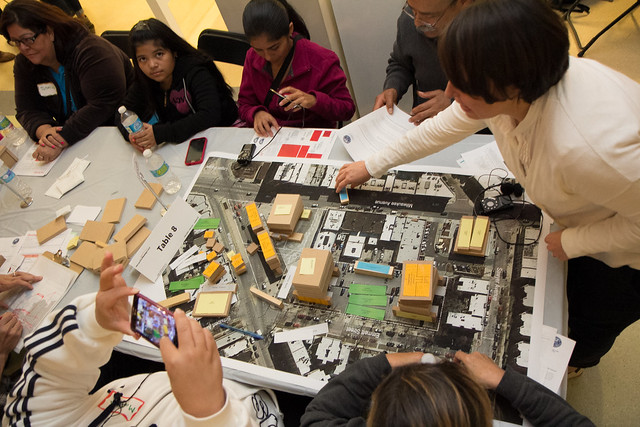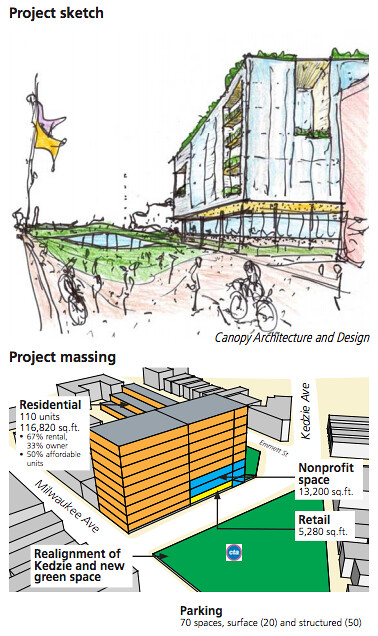On Tuesday, the Metropolitan Planning Council concluded the Corridor Development Initiative, a series of three public meetings that brought area residents together to envision a new development atop the entrance to the Logan Square 'L' station. 35th Ward Alderman Rey Colón enthusiastically noted that this was by far the best-attended of the three meetings. The meeting, he also said, clearly demonstrated the difficult (and expensive) trade-offs necessary in the development process, and especially if this development will accommodate the many different goals that emerged during the meetings.
The two earlier meetings started with a broad discussion about community needs and then used wooden blocks to shape those ideas into three-dimensional proposals. While MPC is preparing a final report, they've set up an online survey to gather feedback from the public, including those who couldn't attend any of the meetings.
The 16 small groups at the second meeting created 28 different development proposals. The average across all the proposals included four-story buildings (about the same height as surrounding structures), with 54 housing units, 9,000 square feet of retail, 40 parking spaces, and open space covering one-third of the site (i.e., about half an acre). Many of the proposals suggested housing (89 percent), retail (79 percent), affordable housing (63 percent), community space (62 percent), and fewer suggested an indoor market (41 percent) or offices (31 percent).
After that meeting, a panel of development industry professionals vetted each of the proposals for financial feasibility. They considered the different uses in each proposal, construction costs, operating costs, rental revenues, the cost of the land (estimated at $6 million), and advantageous financing sources like federal Low Income Housing Tax Credits and the city's Tax Increment Financing. This analysis turned up a "funding gap" for every proposal, indicating that several million more dollars would have to be found in order to build the suggested structure.
Four of the 28 proposals, including the two pictured here, were studied in greater detail by the professionals and illustrated by architects. (All of the proposals were described and illustrated in materials handed out at the meeting and available at MPC's website.) MPC presented these four scenarios, along the constructive suggestions that would make the scenario financially feasible. In the scenario illustrated above, for example, the financial analysis found that the proposal would need an additional $5.6 million to be buildable. Those funds, the panel suggested that one-fourth of the proposal's open space be replaced with retail or residential buildings -- but, when asked, the meeting attendees rejected that idea.
Another example scenario suggested a nine-story building, with half dedicated to 55 affordable housing units. The scenario also realigned Kedzie Avenue to create a new green space to its east (in front of El Cid and G-Mart Comics), which Bridget Stalla from the Chicago Department of Transportation confirmed to be technically possible. Many meeting attendees thought that the building's scale was inappropriate for the neighborhood. The panel suggested that cutting the number of affordable housing units, or community office space, would make the development financially feasible. But, for this proposal as with all the others, the attendees voted down the bean-counters' bottom-line suggestion.
The development panel concluded the meeting with final thoughts and a question-and-answer session. The panel included Mikki Anderson of the Michaels Organization, Sarah Wick from Related Midwest, and Todd Cabanban from Cabanban Rubin & Mayberry Commercial Realty. Anderson pointed out that many of the affordable housing proposals could be built if they managed to win additional Low Income Housing Tax Credits, but that those credits are in very high demand and typically go to large developments with many apartments. She agreed with the crowd that the neighborhood's architectural integrity was valuable, but noted that it was difficult to find exactly the right architect and to exactly re-create the style of historic buildings.
Wick recognized the overwhelming support for affordable housing among community members, and noted that higher density and fewer parking spaces can both make costs more manageable. On the other hand, realigning Kedzie Avenue would be expensive, she said, and would likely have to be paid for by the city rather than by a developer.
Cabanban took a different tack, calling the site "a great intersection for retail" and noting nearby proposals that would tap into that demand -- and could even generate funds that could cover costs for affordable housing. But retail can be a fickle market, and in response to questions he noted that retailers still want parking on-site, and often turn down older storefronts with outdated equipment.

Alderman Rey Colón closed with a few comments, noting that city TIF funds could also be used to fill the funding gap -- if the community truly coalesced behind a proposal that offered clear benefits. Prospective developers are already interested in this site, particularly since the community is willing to entertain at least some development on the site, and real proposals will be forthcoming.






